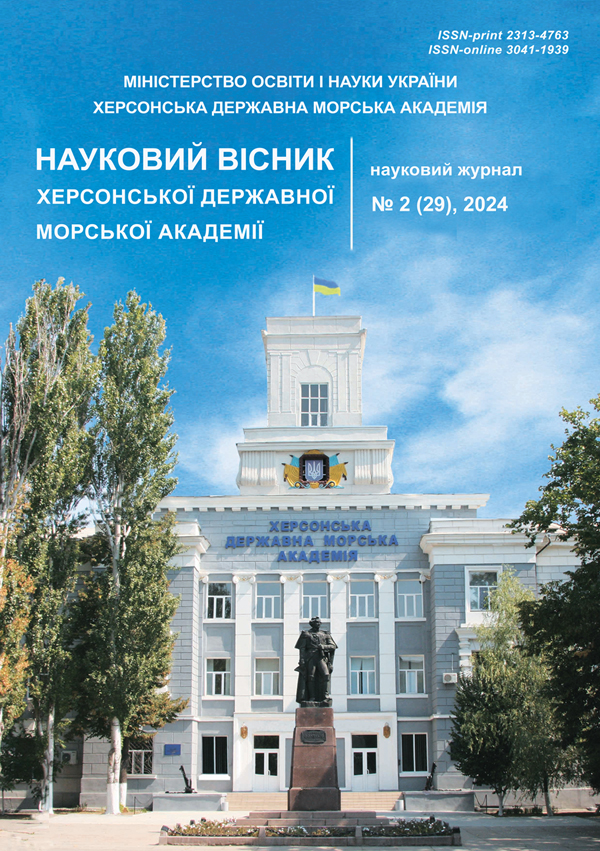DEVELOPMENT OF A NAVIGATOR QUALIFICATION MODEL FOR AUTOMATED SHIP HANDLING CONTROL TASKS
https://doi.org/10.33815/2313-4763.2024.2.29.006-023
Abstract
The study aims to develop a comprehensive qualification model for navigators in automated ship control, evaluating technical, cognitive, and behavioral competence to enhance real-time decision-making in variable navigational environments.
The main challenge is integrating advanced technologies like artificial intelligence and fuzzy logic to accurately monitor risks arising from human factors.
The methodology involves creating a model that assesses navigator competencies by integrating various aspects. Data from ECDIS and other sensors are processed into a feature vector. The Mamdani algorithm aggregates fuzzy rules defining qualification parameters, while neural networks model complex interrelationships. The model uses fuzzy membership functions to assess risks considering speed, under-keel depth, weather conditions, and collision probability.
Results show the model detects potential risks timely and automates decision-making, reducing navigator workload in challenging conditions. It effectively predicts ship trajectory, identifies risky zones, and provides safety recommendations.
Practically, it enhances maritime safety through personalized navigator assessment. Integration with existing systems like ECDIS offers flexibility without major infrastructural changes. The system individualizes recommendations, reducing accident risk and improving training efficiency. Future research includes expanding the training database, refining algorithms, and studying the impact of the navigator's psychophysiological state on ship management effectiveness.
References
2. Liu, Wenwen & Liu, Yuanchang & Gunawan, Bryan & Bucknall, Richard (2020). Practical Moving Target Detection in Maritime Environments Using Fuzzy Multi-sensor Data Fusion. International Journal of Fuzzy Systems. 23. 10.1007/s40815-020-00963-1.
3. Du, Zhixiu (2024). A Risk Assessment Model for Navigation Safety of Maritime Aquaculture Platform Based on AIS Ship Trajectory. Journal of Electrical Systems. 20. 116–123. 10.52783/jes.2364.
4. Devikala, S. (2024). Development of Fuzzy Logic Controller in Automatic Vehicle Navigation using IoT. Journal of Electrical Systems. 20. 114–121. 10.52783/jes.1254.
5. Gül, Muhammet & Ak, Muhammet Fatih (2022). Occupational Risk Assessment for Flight Schools: A 3,4-Quasirung Fuzzy Multi-Criteria Decision Making-Based Approach. Sustainability. 14. 9373. 10.3390/su14159373.
6. Wang, Shaobo & Zou, Yiyang & Wang, Xiaohui (2024). An Intelligent Decision-Making Approach for Multi-Ship Traffic Conflict Mitigation from the Perspective of Maritime Surveillance. Journal of Marine Science and Engineering. 12. 1719. 10.3390/jmse12101719.
7. Aylward, Katie & Weber, Reto & Lundh, Monica & MacKinnon, Scott & Dahlman, Joakim (2022). Navigators’ views of a collision avoidance decision support system for maritime navigation. Journal of Navigation. 75. 1–14. 10.1017/S0373463322000510.
8. Wang, Yuqing & Chen, Xinqiang & Wu, Yuzhen & Zhao, Jiansen & Postolache, Octavian & Liu, Shuhao (2024). Visual Navigation Systems for Maritime Smart Ships: A Survey. Journal of Marine Science and Engineering. 12. 1781. 10.3390/jmse12101781.
9. Li, Wei & Chen, Weijiong & Guo, Yunlong & Hu, Shenping & Xi, Yongtao & Wu, Jianjun (2024). Risk Performance Analysis on Navigation of MASS via a Hybrid Framework of STPA and HMM: Evidence from the Human–Machine Co-Driving Mode. Journal of Marine Science and Engineering. 12. 1129. 10.3390/jmse12071129.
10. Houweling, Koen & Mallam, Steven & van de Merwe, Koen & Nordby, Kjetil (2023). An Approach for Measuring The Effects of Augmented Reality on Human Performance in Maritime Navigation. Proceedings of the Human Factors and Ergonomics Society Annual Meeting. 67. 10.1177/21695067231193647.
11. Mohamed, Eslam & Hosny, Moustafa (2024). Enhancing Safety of Navigation with ECDIS Standardization and S-Mode Adoption. Maritime Research and Technology. 3. 117. 10.21622/MRT.2024.03.2.932.
12. Lee, Changui & Seojeong, Lee (2024). A Risk Identification Method for Ensuring AI-Integrated System Safety for Remotely Controlled Ships with Onboard Seafarers. Journal of Marine Science and Engineering. 12. 1778. 10.3390/jmse12101778.
13. Lei, Jinyu & Sun, Yuan & Wu, Yong & Zheng, Fujin & He, Wei & Liu, Xinglong (2024). Association of AIS and Radar Data in Intelligent Navigation in Inland Waterways Based on Trajectory Characteristics. Journal of Marine Science and Engineering. 12. 890. 10.3390/jmse12060890.
14. Car, Maro & Vujicic, Srdjan & Žuškin, Srđan & Brčić, David (2019). Human Machine Interface: Interaction of OOWs with the ECDIS system. Conference: 1st International Conference of Maritime Science & Technology – Naše More 2019.
15. Medic, Dario & Bošnjak, Rino & Bukljaš, Mihaela & Vukša, Srđan (2021). Research Study and the Model for Improving the Safety of Navigation when Using the AIS. TransNav the International Journal on Marine Navigation and Safety of Sea Transportation. 15. 577. 10.12716/1001.15.03.10.
16. Liu, Tian & MA, Jianwen (2022). Ship Navigation Behavior Prediction based on AIS Data. IEEE Access. 10. 1–1. 10.1109/ACCESS.2022.3172308.
17. Jiang, Zhiqiang & Zhang, Lingyu & Li, Weijia (2024). A machine vision method for the evaluation of ship-to-ship collision risk. Heliyon. 10. e25105. 10.1016/j.heliyon.2024.e25105.
18. Vukić, Đurđica & Candrlic, Sanja & Poščić, Patrizia (2020). COMPARATIVE OVERVIEW OF ADAPTIVE ASSESSMENT ACTIVITY IN OPEN SOURCE LMS: DATA MODEL PERSPECTIVE. 4944–4954. 10.21125/inted.2020.1356.
19. Moon, Kibum & Kim, Jinwon & Lee, Jinsook (2021). Early Prediction Model of Student Performance Based on Deep Neural Network Using Massive LMS Log Data. The Journal of the Korea Contents Association. 21. 1–10. 10.5392/JKCA.2021.21.10.001.
20. Putra, Bagas & Soeprijanto, & Daryanto (2024). Evaluation of the Utilization of the Learning Management System (LMS) Using the CIPP Model. Global Synthesis in Education Journal. 1. 19-27. 10.61667/dp8q3757.
21. Elov, Botir & Rasulovna, Jamoldinova & Mastura, Primova & Khusainova, Zilola & Raxmatilloyevich, Aloyev & O'g'li, Xudayberganov (2024). The Stages of Creation of LMS Model.
22. Liu, Dongqin & Zheng, Zhongyi & Liu, Zihao (2024). Research on Dynamic Quaternion Ship Domain Model in Open Water Based on AIS Data and Navigator State. Journal of Marine Science and Engineering. 12. 516. 10.3390/jmse12030516.
23. Okechukwu, Ogochukwu & Amaechi, Eziechina & George, Onyemachi & Isaac, Onuwa (2024). Enhanced Text Recognition in Images Using Tesseract OCR within the Laravel Framework. Asian Journal of Research in Computer Science. 17. 58–69. 10.9734/ajrcos/2024/v17i9499.
24. Manjunath, Akanksh & Nayak, Manjunath & Nishith, Santhanam & Pandit, Satish & Sunkad, Shreyas & Deenadhayalan, Pratiba & Gangadhara, Shobha (2023). Automated invoice data extraction using image processing. IAES International Journal of Artificial Intelligence (IJ-AI). 12. 514. 10.11591/ijai.v12.i2.pp514–521.
25. Sumana, K. R. (2024). Optimized OCR Data Extraction Using Custom-Trained NLP-NER Models for Enhanced Image Analysis. Journal of Emerging Technologies and Innovative Research. 11. 159–162.
26. Ujkani, Arbresh & Hohnrath, Pascal & Grundmann, Robert & Burmeister, Hans-Christoph (2024). Enhancing Maritime Navigation with Mixed Reality: Assessing Remote Pilotage Concepts and Technologies by In Situ Testing. Journal of Marine Science and Engineering. 12. 1084. 10.3390/jmse12071084.
27. Martes, Liliana (2020). Best Practices in Competency-based Education in Maritime and Inland Navigation. TransNav, the International Journal on Marine Navigation and Safety of Sea Transportation. 14. 557–562. 10.12716/1001.14.03.06.
28. Victoria Ponomaryova, Pavlo Nosov (2023). Method of automated identi-fication of qualification parameters for marine operators under risk conditions // Naukovyi visnyk Khersonskoi derzhavnoi morskoi akademii (Avtomatyzatsiia ta kompiuterno-intehrovani tekhnolohii): naukovyi zhurnal. – Kherson: Khersonska derzhavna morska akademiia, № 26–27 (2023). S. 144–165.
29. Ponomaryova, V., Nosov, P., Ben, A., Popovych, I., Prokopchuk, Y., Mamenko, P., Dudchenko, S., Appazov, E., & Sokol, I. (2024). Devising an approach for the automated restoration of shipmaster’s navigational qualification parameters under risk conditions. Eastern-European Journal of Enterprise Technologies, 1(3 (127), 6–26. https://doi.org/10.15587/1729-4061.2024.296955.
30. Victoria Ponomaryova (2024). Method of decision support for navigators in automated vessel traffic safety control based on ecdis data // Naukovyi visnyk Khersonskoi derzhavnoi morskoi akademii (Avtomatyzatsiia ta kompiuterno-intehrovani tekhnolohii): naukovyi zhurnal. Kherson: Khersonska derzhavna morska akademiia, № 1 (28), 2024. S. 22–40.






